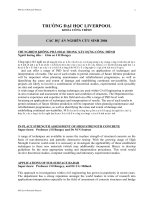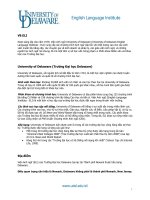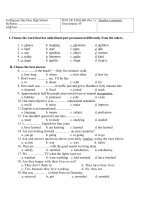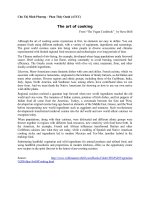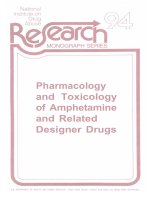toxicology of opiates
Bạn đang xem bản rút gọn của tài liệu. Xem và tải ngay bản đầy đủ của tài liệu tại đây (269.82 KB, 47 trang )
07/15/14 Gold Coast 1999 1
Toxicology of Opiates
Dr. George Braitberg
Austin and Repatriation
Medical Centre
Heidelberg Victoria
07/15/14
Gold Coast 1999 2
Opiates and Opioids
•
Opiate refers to a substance that originates
from opium, and is gained out of the latex of
the capsule of the opium plant, Papaver
somniferous
•
Opioid is the term used for substances with an
analogue effect to morphine. Opioids are
ligands on opioid-receptors and they possess
an intrinsic activity.
07/15/14
Gold Coast 1999 3
Opiates and Opioids
Not all opiates bond to opioid-
receptors: not all opiates are
opioids
07/15/14
Gold Coast 1999 4
Opiates
Opiates are the
approximately 20 natural
substances
from the opium-juice of
poppy seed capsule
07/15/14
Gold Coast 1999 5
Opiates
Morphine
Codeine (3-ortho-methyl-
morphine)
Papaverine
Noscapine
07/15/14
Gold Coast 1999 6
Opioids
Opioids are substances with
effects similar to morphine:
•
Natural opioids, opioid opiates
•
Semi -synthetic opioids
•
Synthetic opioids
•
Active metabolic products from
Heroin and Morphine
•
Endogenic, opioid peptides
07/15/14
Gold Coast 1999 7
Opioids with morphine like action
Phenanthrenes: are opium alkaloids that have
an effect analogue to that of morphine. They
are opioid effective opiates.
Morphine (Morphium): raw opium contains 10-
17% morphine
Codeine: is used mainly as an antitussive.
Raw opium contains 1-4% codeine.
07/15/14
Gold Coast 1999 8
Opioids with no morphine like
action
Thebaine:starting substance for synthesis of
naloxone, naltrexone and buprenorphine; has
only a very slight effect on it’s own.
Benzylisochinoline: are opium alkaloids which
have no effect analogue to that of morphine.
Papaverine: Phosphodiesterase inhibitor:
works mainly spasmolytic.
Noscapine: antitussive without addiction
potential. Raw opium contains 2-9% noscapine.
07/15/14
Gold Coast 1999 9
Semisynthetic Opioids
Heroin (DAM, Diamorphine
3,6-O-Diacetylmorphine)
Hydromorphone
Nicomorphine
Dihydrocodeine
Hydrocodone (Dihydrocodeinone)
Buprenorphine
07/15/14
Gold Coast 1999 10
Synthetic Opioids
Methadone
Dextromoramide
Tilidine
Pethidine
Pentazocine
07/15/14
Gold Coast 1999 11
Endogenous opioids
Beta-endorphin is a peptide-opioid
substance found in the body
07/15/14
Gold Coast 1999 12
Morphine - opioid and opiate
Morphine
–
Analgesic, natural opioid
–
Duration of effect:
4-5 hours; in retard form 6-12
hours
–
Elimination half-life:
3 hours (also in retard form)
–
Minimal deadly dose:
•
25 mg i.v./ 50 mg po.
07/15/14
Gold Coast 1999 13
Codeine - opioid and opiate
Codeine
•
Antitussive
•
(Analgesic)
•
Duration of effect:
4-6 hours
•
Elimination half-life
3-4 hours
07/15/14
Gold Coast 1999 14
Semisynthetic Opioids
Heroin
Hydromorphone
•
Analgesic
•
Duration of effect: 4-5 hours
•
Elimination half-life: 0.5 hours
•
Minimal deadly dose: 25 mg i.v.
•
from morphine through acetylation by acetic acid
anhydride
•
Analgesic
•
Duration of effect: 4-5 hours
•
Elimination half-life: 2.5 hours
07/15/14
Gold Coast 1999 15
Semisynthetic Opioids
Nicomorphine
Dihydrocodeine
Analgesic
Duration of effect: 4-5 hours
Elimination half-life: 2-3 hours
Antitussive, (Analgesic)
Duration of effect: 4-5 hours
Elimination half-life: 4 hours
07/15/14
Gold Coast 1999 16
Semisynthetic Opioids
Hydrocodone
Buprenorphine
antitussive
Duration of effect: 8-10 hours
Elimination half-life: 4 hours
Analgesic
Duration of analgetic effect: 6-8 hours
Duration of withdrawal prevention effect in
high doses up to 48 hours
Elimination half-life: 5 hours
Agonist/Antagonist; synthetised out of Thebain
07/15/14
Gold Coast 1999 17
Synthetic Opioids
Methadone
•
Analgesic
•
Duration of analgetic effect: 8-48 hours
•
Duration of withdrawal prevention effect in
high doses: rarely less than 24 hours
•
Elimination half-life: 15-22 hours
•
Minimal deadly dose : 25 mg i.v.;
•
50 mg p.o.; (25 mg L-Methadone p.o)
07/15/14
Gold Coast 1999 18
Synthetic Opioids
Dextromoramide
Tilidine
Pentazocine
•
Analgesic
•
Analgesic
–
Duration of effect: 4-6 hours
–
Elimination half-life: 3-5 hours
•
Analgesic
–
Duration of effect: 3 hours
–
Elimination half-life: 2-3 hours
–
Takes effect on κ -Receptoren agonistically
and on the µ -Receptoren antagonistially
07/15/14
Gold Coast 1999 19
Pethidine
•
Analgesic
–
Duration of effect: 2-4 hours
–
Elimination half-life: 2.5-3 hours
07/15/14
Gold Coast 1999 20
Heroin Addiction
Heroin is an opioid that is
biotransformed in the body ultimately to
morphine (Heroin -> 6-
monoacetylmorphine (6MAM) ->
morphine).
Heroin and morphine produce analgesia
by acting on the mu (µ)-type opioid
receptors in the brain. action of heroin
vs. morphine are clearly separable.
07/15/14
Gold Coast 1999 21
Heroin Addiction
In mice (Swiss Webster, SW), heroin
acts on delta-type opioid receptors.
By using specific antagonists, the
action of heroin and morphine are
clearly separable.
These studies may provide the basis
for relating genetic factors to
differences in response between
heroin and morphine
07/15/14
Gold Coast 1999 22
Heroin Addiction
The analgesic action of µ opioid
agonists such as morphine occurs in
the brain but activates neurons in the
spinal cord which release
norepinephrine and serotonin. When
heroin acts on delta receptors in the
brain a different set of neurons are
activated which release a different
neurotransmitter, GABA, to produce
analgesia.
07/15/14
Gold Coast 1999 23
Opiate Withdrawal Syndrome
Eye watering, runny nose, yawning, sweating
Occurs within 8-12 hours of last heroin
Followed by restlessness, piloerection,
mydirasis, tremor, anorexia, bone and joint
pain, muscle cramps.
Symptoms peak at 48-72h
Symptoms disappear at 7-10 days
General malaise and craving lasts months
Rarely life threatening
07/15/14
Gold Coast 1999 24
Naltrexone
Naltrexone is a long acting potent pure
narcotic antagonist. Clinical pharmacology
studies demonstrated that oral naltrexone
at 50, 100 and 150mg effectively blocks
the physiological and subjective effects of
parenterally administered heroin,
hydromorphone or morphine for 24, 48
and 72 hours respectively.
07/15/14
Gold Coast 1999 25
Naltrexone
The lowest effective plasma
naltrexone concentration of 2ng/ml
provided an average of 86.5%
blockade of 25mg IV heroin effects.
In sustain released therapy for
opiate antagonist activity, plasma
level of naltrexone should be kept
above 2ng/ml
